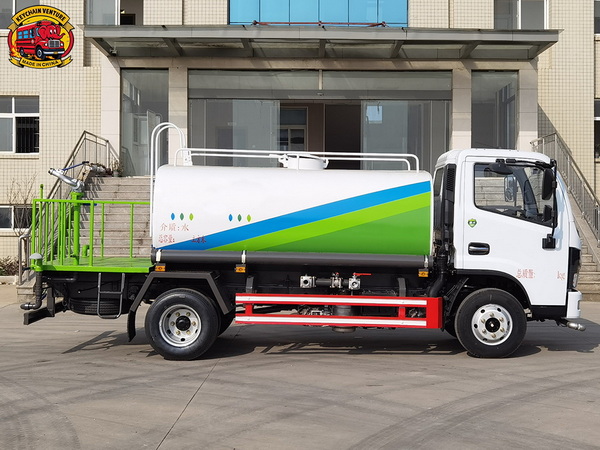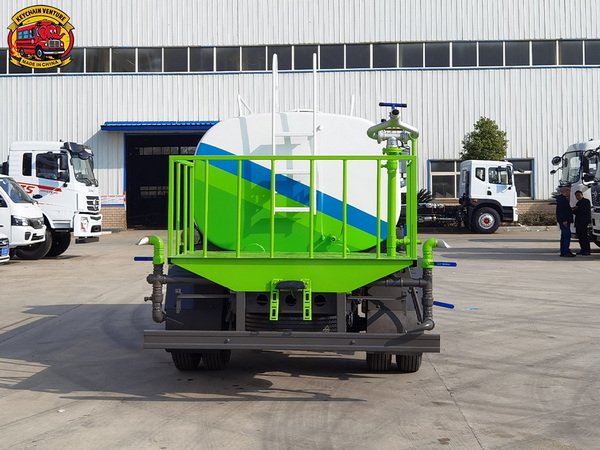Views: 222 Author: Amanda Publish Time: 2025-10-29 Origin: Site








Content Menu
● Rediscovering the Industrial Soul
● How a Water Truck Is Built and Why It Matters
● Selecting the Right Base Model for Conversion
● Conceptualizing the Design: From Utility to Culinary Art
● Engineering and Fabrication Process
● Integrating Modern BBQ Technology
● Safety and Regulation Compliance
● Sustainability and Circular Design
● Expanding Into a Thriving Business
● The Cultural Appeal of Fire and Steel
● FAQ
>> 1. What is the average cost to build a Water Truck BBQ?
>> 2. How long does the conversion take?
>> 3. What's the best type of Water Truck tank?
>> 4. Can the truck still drive after the modification?
>> 5. Do I need a license to operate it as a food truck?
When you think of a Water Truck, what often comes to mind is a rugged, industrial machine trundling down a dusty road, spraying water to settle the earth or serving on construction sites. Yet beneath its utilitarian exterior lies something more: enormous potential for creative reinvention. Imagine converting that massive tank into a functioning BBQ grill—a feat that blurs the line between mechanic craftsmanship and culinary artistry. This visionary project not only recycles an old machine but transforms it into an unforgettable centerpiece for outdoor gatherings, festivals, or business promotions.

The global trend toward sustainability and eco-friendly reuse has inspired people everywhere to view machines differently. Rather than consigning an old Water Truck to the scrapyard, innovative fabricators now see it as a blank canvas. From its heavy-duty chassis to its robust tank shell, every part has a potential new purpose.
In recent years, converting industrial vehicles—especially fire engines and Water Trucks—into luxury BBQ rigs or themed hospitality units has gained traction. It combines mechanical engineering, welding artistry, and a deep respect for design aesthetics. The result? A one-of-a-kind culinary stage that inspires awe and sparks conversations.
A traditional Water Truck is engineered for endurance. It typically includes:
- A thick steel or aluminum tank designed to withstand constant pressure.
- Heavy-frame chassis fitted with robust suspensions.
- Pumps, hoses, and valves for fluid distribution.
- A high-torque diesel engine for consistent hauling power.
These manufacturing features mean the structure already has the resilience needed to accommodate heavy modifications—such as turning that tank into a firebox chamber. You're not starting from scratch; you're upgrading a machine built to work hard and last decades.
That mechanical strength makes a Water Truck perfect for custom projects that involve heat, load, and constant outdoor operation.
Not every Water Truck is a suitable base for BBQ conversion. Choosing wisely will save time, money, and frustration later. Consider:
- Tank history: Was the truck used for potable water transport? Avoid tanks previously used for chemicals or waste disposal.
- Structural integrity: Check for corrosion beneath the tank and along weld joints.
- Chassis condition: Look for cracks, rust, and suspension quality.
- Size: Trucks between 10,000–20,000 liters are large enough to hold equipment but still mobile enough for festivals.
Many fabricators purchase second-hand Water Trucks from government or construction auctions. The savings are significant, and many units require only minor refinishing.
Turning an industrial vehicle into a BBQ is like sculpting metal with both functionality and aesthetics in mind. The planning phase defines the ultimate look and experience. Decide early whether your Water Truck BBQ will be stationary or mobile, as this affects every design choice.
Some popular design concepts include:
- Tank Smoker: The water tank becomes the main smoking chamber, with functioning doors, racks, and temperature gauges.
- Mobile Grill Deck: Removing the top section of the tank creates a flat cooking deck fitted with adjustable grills.
- Dual-Chamber System: One part of the tank serves as a smoker, the other as a side firebox and prep area.
- Hospitality Extension: Expand the rear of the truck with shade structures, fold-out tables, or even dining counters.
This stage usually involves CAD modeling or collaboration with a workshop specializing in automotive conversions.
Here's where sparks literally fly. The Water Truck's metal hull needs careful cutting, reinforcement, and finishing to function as a safe, effective grill system.
Key steps include:
1. Tank Cleaning: Remove any residue through sandblasting and chemical neutralization.
2. Structural Conversion: Use plasma cutters to carve door openings, smoke vents, and mounting slots.
3. Steel Reinforcement: Reinforce critical areas with fireproof liner materials to prevent heat deformation.
4. Mounting the Firebox: Attach heat-resistant, insulated compartments either inside or external to the tank.
5. Install Smoke Control: Build exhaust stacks to maintain consistent airflow.
6. Add Thermostatic Gauges: Ensure safe and controllable cooking temperatures.
At this stage, craftsmanship and precision ensure the BBQ won't just look impressive—it will perform flawlessly.

Modern Water Truck BBQs often integrate cutting-edge features that elevate their functionality beyond classic pit smoking. Popular enhancements include:
- Smart Temperature Management: Digital control panels manage airflow and heat.
- Bluetooth Monitoring: Sync with mobile apps for real-time cooking oversight.
- Automatic Fuel Feeders: Regulate charcoal or pellet combustion automatically.
- Solar Roof Panels: Power lighting, music systems, or refrigeration units.
- Integrated Cooling Drawers: Utilize former pump cavities as refrigerated storage.
Through these innovations, the once dusty Water Truck transforms into a self-sufficient, fully interactive outdoor kitchen that impresses chefs and guests alike.
Bringing your converted Water Truck BBQ into public spaces creates a magnetic effect. At events, exhibitions, or festivals, it becomes an attraction long before the food is even served. Few things capture attention more than an old industrial vehicle breathing aromatic smoke while people line up for brisket.
Custom paint jobs amplify the visual appeal. Some owners brand their water truck smokers with bold logos or LED lighting to create a nighttime spectacle. Others keep the raw metallic look, letting the vehicle's working past shine through its industrial scars.
For businesses, this is marketing gold—a rolling billboard that feeds people and fascinates them.
Safety is paramount when turning a combustion-based appliance into a mobile platform. Ensure that every structural and mechanical modification follows regional and national fire codes.
Recommended precautions:
- Obtain fire department inspection certificates.
- Install accessible extinguishers and emergency shutoffs.
- Label all flammable zones clearly.
- Ground all electrical attachments.
- If stationary, create concrete or gravel flooring beneath your unit.
A safe Water Truck BBQ is not only legally compliant but also trusted by customers and event organizers.
Recycling a Water Truck is more than an engineering exercise—it is sustainability in action. You extend the lifespan of hundreds of kilograms of steel, reduce industrial waste, and reimagine how heavy-duty machinery can serve communities in new, exciting ways.
From an ecological standpoint, reusing an existing chassis saves both energy and emissions compared to producing a new steel frame. Moreover, public attention toward circular design means that your project doubles as an environmental statement.
In food festivals and tourism markets, brands that align sustainability with creativity gain distinctive reputations. The Water Truck BBQ thus becomes not only a spectacle but also a symbol of responsible innovation.
Around the world, several visionary builders have redefined what a Water Truck can become:
- In Texas, a mechanics collective re-engineered a tanker into a 24-foot smoker that now serves barbecue for community fundraisers.
- In Beijing, an old municipal Water Truck was redesigned into a street-side culinary icon serving local specialties.
- In Australia, rural engineers turned a mining Water Truck into a family-run mobile BBQ business touring outback events.
- In Poland, a creative studio built a dual-purpose stage and BBQ truck for music festivals.
Each project tells a story: transformation, pride, and a deep respect for craftsmanship and creativity.
A converted Water Truck BBQ doesn't just feed people—it can build a brand. The potential for entrepreneurship is vast:
- Event Catering: Rent the BBQ truck for private parties, weddings, or street events.
- Brand Collaborations: Partner with beverage companies or local farms.
- Touring Shows: Participate in grill contests and food fairs.
- Advertising Platform: Wrap the truck in large-scale decals or offer ad space.
Marketing thrives on storytelling. When your product is literally built from a retired industrial vehicle, your narrative already stands out. Each flame and plate of smoked meat adds to the legend of transformation.
Though rewarding, the process isn't without challenges:
- Fabrication costs: Welding, cutting, and safety reinforcements are labor-intensive.
- Legal paperwork: Registrations and retrofitting certifications vary by region.
- Maintenance: Exposure to smoke and heat shortens metallic lifespan.
- Fuel logistics: Managing propane or charcoal on a large scale demands oversight.
Despite these hurdles, the financial returns—enhanced brand recognition, marketing impact, and sheer crowd appeal—often far outweigh the effort.
Beyond function and business, the Water Truck BBQ embodies the human fascination with fire and transformation. The sight of glowing coals reflected on polished steel invites community gathering, storytelling, and laughter. Every whiff of smoke carries traces of the machine's history—hard work repurposed into pure enjoyment.
From industrial power to communal warmth, this striking metamorphosis represents the best of modern creativity: blending sustainability, design, and emotion.
Transforming a Water Truck into a BBQ is more than a flashy engineering project. It's an artistic fusion of sustainability, performance, and hospitality—a physical symbol of how innovation breathes new life into steel. It unites welders, mechanics, and food lovers under one shared vision: turning old industry into new delight. Whether your purpose is aesthetic, entrepreneurial, or simply adventurous, the flame of creativity can make even a humble Water Truck a legend of the open road and open fire.

Depending on complexity, material quality, and added technology, conversions typically cost between $7,000 and $35,000.
A full transformation can take 6–10 weeks for a professional team, or longer for hobbyists working part-time.
Food-grade steel tanks that previously carried potable water work best. Avoid any that transported chemicals.
Yes, provided the chassis, engine, and suspension remain operational. Many owners retain mobility for event catering.
In most regions, yes. You must comply with mobile food vendor laws and fire safety regulations before public use.